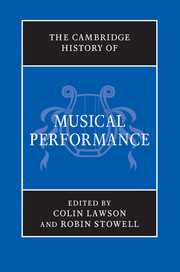Book contents
- Frontmatter
- PART I PERFORMANCE THROUGH HISTORY
- PART II PRE-RENAISSANCE PERFORMANCE
- PART III PERFORMANCE IN THE RENAISSANCE (C. 1430–1600)
- PART IV PERFORMANCE IN THE SEVENTEENTH CENTURY
- PART V PERFORMANCE IN THE ‘LONG EIGHTEENTH CENTURY’
- PART VI PERFORMANCE IN THE NINETEENTH CENTURY
- PART VII THE TWENTIETH CENTURY AND BEYOND
- 28 Musical performance in the twentieth century and beyond: an overview
- 29 Vocal performance in the twentieth century and beyond
- 30 Instrumental performance in the twentieth century and beyond
- 31 Case study: Karlheinz Stockhausen, Gruppen für drei Orchester
- PART VIII
- Index
29 - Vocal performance in the twentieth century and beyond
from PART VII - THE TWENTIETH CENTURY AND BEYOND
Published online by Cambridge University Press: 28 March 2012
- Frontmatter
- PART I PERFORMANCE THROUGH HISTORY
- PART II PRE-RENAISSANCE PERFORMANCE
- PART III PERFORMANCE IN THE RENAISSANCE (C. 1430–1600)
- PART IV PERFORMANCE IN THE SEVENTEENTH CENTURY
- PART V PERFORMANCE IN THE ‘LONG EIGHTEENTH CENTURY’
- PART VI PERFORMANCE IN THE NINETEENTH CENTURY
- PART VII THE TWENTIETH CENTURY AND BEYOND
- 28 Musical performance in the twentieth century and beyond: an overview
- 29 Vocal performance in the twentieth century and beyond
- 30 Instrumental performance in the twentieth century and beyond
- 31 Case study: Karlheinz Stockhausen, Gruppen für drei Orchester
- PART VIII
- Index
Summary
Of styles and genres
The vast and far-reaching changes in musical style that have occurred in the past hundred years make it a richly rewarding period for singers. Faced with such a chaotic and variegated tapestry of stylistic strands, ranging from the truly bizarre to the comfortably familiar, the contemporary singer can be forgiven for proceeding with extreme caution. Yet, for those committed to keeping in touch with the new, it is a privilege to be caught up in the aftermath of the early twentieth century's exhilarating maelstrom of contrasting artistic influences, inspirations, experiments and occasional shockwaves, all of which reverberate to the present day.
At the beginning of the twentieth century, many European ‘late Romantic’ composers were working within the basic vocal traditions of the nineteenth century, while others had chosen to strike out in bracing new directions. In opera, composers such as Puccini (1858–1924) and Richard Strauss (1864–1949) maintained the tradition of predominantly lyrical writing, with a growing diversity of vocal characterisation, and the less-known figures of Franz Schreker (1878–1934) and Erich Korngold (1897–1957) enjoyed runaway successes with Der ferne Klang (1912) and Die tote Stadt (1920). The emergence across Eastern Europe of a new kind of pungently declamatory vocal writing, pioneered in the previous century by Musorgsky (1839–81), found its fulfilment in the Janáček operas, and those of Prokofiev (1891–1953) and Shostakovich (1906–75).
- Type
- Chapter
- Information
- The Cambridge History of Musical Performance , pp. 752 - 777Publisher: Cambridge University PressPrint publication year: 2012
- 1
- Cited by

